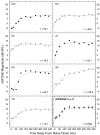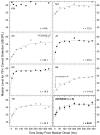Overshoot measured physiologically and psychophysically in the same human ears
- PMID: 20430072
- PMCID: PMC2923227
- DOI: 10.1016/j.heares.2010.04.007
Overshoot measured physiologically and psychophysically in the same human ears
Erratum in
- Hear Res. 2011 Oct;280(1-2):246
Abstract
A nonlinear version of the stimulus-frequency otoacoustic emission (SFOAE) was measured using stimulus waveforms similar to those used for behavioral overshoot. Behaviorally, the seven listeners were as much as 11 dB worse at detecting a brief tonal signal (4.0 kHz, 10 ms in duration) when it occurred soon after the onset of a wideband masking noise (0.1-6.0 kHz; 400 ms in duration) than when it was delayed by about 200 ms, and the nonlinear SFOAE measure exhibited a similar effect. When either lowpass (0.1-3.8 kHz) or bandpass noise (3.8-4.2 kHz) was used instead of the wideband noise, the physiological and behavioral measures again were similar. When a highpass noise (4.2-6.0 kHz) was used, the physiological and behavioral measures both showed no overshoot-like effect for five of the subjects. The physiological response to the tone decayed slowly after the termination of the noise, much like the time course of resetting for behavioral overshoot. One subject exhibited no overshoot behaviorally even though his cochlear responses were like those of the other subjects. Overall, the evidence suggests that some basic characteristics of overshoot are obligatory consequences of cochlear function, as modulated by the olivocochlear efferent system.
Copyright (c) 2010 Elsevier B.V. All rights reserved.
Figures










Similar articles
-
Use of stimulus-frequency otoacoustic emissions to investigate efferent and cochlear contributions to temporal overshoot.J Acoust Soc Am. 2009 Mar;125(3):1595-604. doi: 10.1121/1.3068443. J Acoust Soc Am. 2009. PMID: 19275317 Free PMC article.
-
Overshoot using very short signal delays.J Acoust Soc Am. 2010 Oct;128(4):1915-21. doi: 10.1121/1.3480568. J Acoust Soc Am. 2010. PMID: 20968363 Free PMC article.
-
Otoacoustic emission estimates of human basilar membrane impulse response duration and cochlear filter tuning.Hear Res. 2016 Dec;342:150-160. doi: 10.1016/j.heares.2016.10.016. Epub 2016 Oct 27. Hear Res. 2016. PMID: 27989947
-
Modeling cochlear dynamics: interrelation between cochlea mechanics and psychoacoustics.J Acoust Soc Am. 2010 Oct;128(4):1870-83. doi: 10.1121/1.3479755. J Acoust Soc Am. 2010. PMID: 20968359
-
Comparing behavioral and physiological measures of combination tones: sex and race differences.J Acoust Soc Am. 2012 Aug;132(2):968-83. doi: 10.1121/1.4731224. J Acoust Soc Am. 2012. PMID: 22894218 Free PMC article.
Cited by
-
Selective attention reduces physiological noise in the external ear canals of humans. I: auditory attention.Hear Res. 2014 Jun;312:143-59. doi: 10.1016/j.heares.2014.03.012. Epub 2014 Apr 13. Hear Res. 2014. PMID: 24732069 Free PMC article.
-
Efferent modulation of hair cell function.Curr Opin Otolaryngol Head Neck Surg. 2011 Oct;19(5):376-81. doi: 10.1097/MOO.0b013e32834a5be1. Curr Opin Otolaryngol Head Neck Surg. 2011. PMID: 22552698 Free PMC article. Review.
-
The effects of broadband elicitor duration on transient-evoked otoacoustic emissions and a psychoacoustic measure of gain reduction.Res Sq [Preprint]. 2025 Aug 12:rs.3.rs-6753082. doi: 10.21203/rs.3.rs-6753082/v2. Res Sq. 2025. PMID: 40502776 Free PMC article. Preprint.
-
Investigating the auditory enhancement phenomenon using behavioral temporal masking patterns.J Acoust Soc Am. 2012 Nov;132(5):3363-74. doi: 10.1121/1.4754527. J Acoust Soc Am. 2012. PMID: 23145617 Free PMC article.
-
Cochlear efferent innervation and function.Curr Opin Otolaryngol Head Neck Surg. 2010 Oct;18(5):447-53. doi: 10.1097/MOO.0b013e32833e05d6. Curr Opin Otolaryngol Head Neck Surg. 2010. PMID: 20717032 Free PMC article. Review.
References
-
- Bacon SP. Effect of masker level on overshoot. J. Acoust. Soc. Am. 1990;88:698–702. - PubMed
-
- Bacon SP, Liu L. Effects of ipsilateral and contralateral precursors on overshoot. J. Acoust. Soc. Am. 2000;108:1811–1818. - PubMed
-
- Bacon SP, Takahashi GA. Overshoot in normal-hearing and hearing-impaired subjects. J. Acoust. Soc. Am. 1992;91:2865–2871. - PubMed
-
- Bacon SP, Repovsch-Duffey JL, Liu L. Effects of signal delay on auditory filter shapes derived from psychophysical tuning curves and notched-noise data obtained in simultaneous masking. J. Acoust. Soc. Am. 2002;112:227–237. - PubMed
-
- Backus BC, Guinan JJ., Jr. Time-course of the human medial olivocochlear reflex. J. Acoust. Soc. Am. 2006;119:2889–2904. - PubMed
Publication types
MeSH terms
Grants and funding
LinkOut - more resources
Full Text Sources
Miscellaneous

